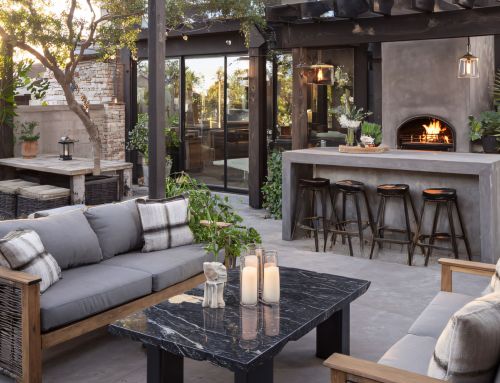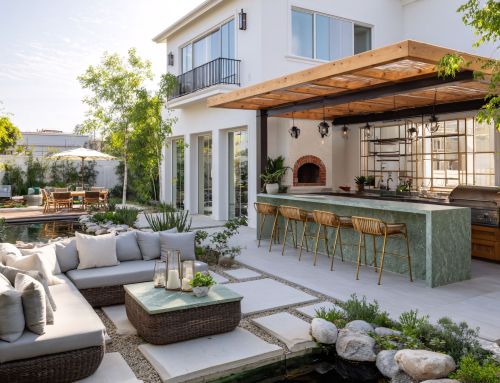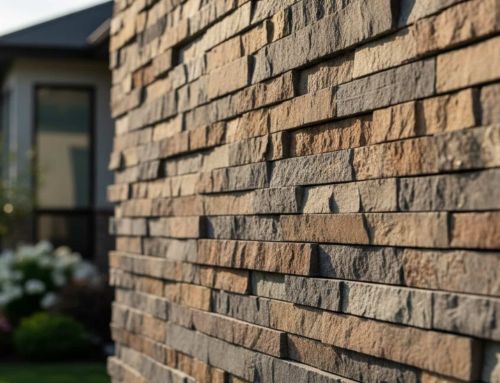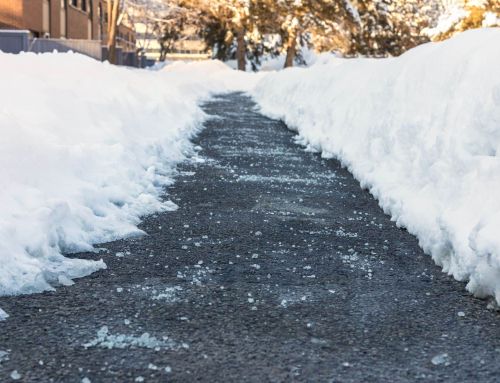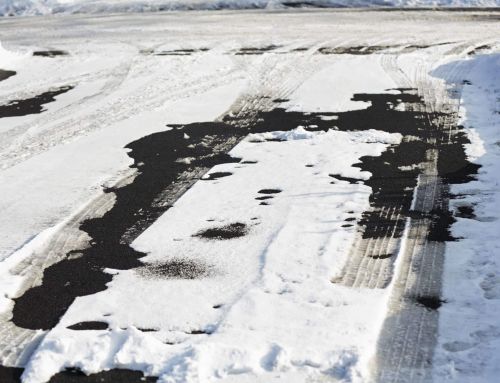Choosing between concrete pavers & slabs is one of the most important steps in creating a functional and beautiful outdoor space. Whether you’re designing a patio, driveway, or garden walkway, the right option can enhance both the look and durability of your project while reflecting your personal style.
From achieving proper drainage to capturing timeless elegance, understanding the differences between these materials helps you make a smart, lasting investment. Let’s explore what sets them apart so you can move forward with confidence.
Understanding Concrete Pavers vs. Slabs
The distinction between pavers and slabs goes beyond just size. Concrete pavers are defined as having a maximum aspect ratio of 4:1, meaning their length is less than four times their thickness. They typically measure at least 2⅜ inches thick and can be lifted with one hand.
Slabs, on the other hand, have an aspect ratio greater than 4:1 with a minimum thickness of 2 inches. They’re usually at least 12 inches in length and require two hands to lift. This fundamental difference affects everything from installation methods to long-term performance.
Types and Applications: Where Each Material Excels
Driveways
For driveways, both concrete pavers and poured slabs offer unique benefits depending on your goals. Concrete pavers are built to handle natural expansion and contraction, which can help minimize cracking. Their interlocking structure also distributes weight efficiently, making them a durable option for supporting vehicles.
One added advantage of pavers is easier access for repairs. If a section gets damaged, individual pieces can be replaced without redoing the entire driveway, making long-term maintenance more manageable.
Patios
Both pavers and slabs work beautifully for patios, but they create different aesthetics. Pavers offer more design flexibility with various shapes, colors, and patterns. You can create intricate designs that enhance your outdoor space’s personality. Slabs provide a more uniform, contemporary look that many homeowners prefer for modern outdoor kitchens and entertaining areas. They’re also faster to install, which can reduce labor costs.
Walkways and Pathways
Pavers excel for curved walkways and paths that wind through your garden. Their smaller size allows for smooth curves and creative patterns that complement natural landscaping. Slabs work best for straight pathways or those with gentle curves. They create clean lines that look particularly striking when grass or decorative stones fill the gaps between slabs.
Pool Decks
Pool decks require materials that provide good traction when wet. Both pavers and slabs can be manufactured with textured surfaces for safety. However, pavers offer better drainage between joints, reducing standing water. The ability to replace individual damaged pavers also makes maintenance easier around pool areas, where chemical exposure and temperature changes can cause wear over time.
Design Possibilities: Colors, Patterns, and Textures
Color Options That Transform Your Space
Today’s concrete pavers and slabs come in an incredible range of colors. From classic gray and brown tones that provide timeless appeal to vibrant options that add warmth and personality to your yard, there’s something to suit every taste.
Natural stone appearances have become increasingly popular, offering the beauty of traditional materials with the durability and consistency of concrete. These options help create outdoor spaces that blend seamlessly with existing landscape elements.
Pattern Variety and Visual Impact
Pavers offer unlimited pattern possibilities:
- Herringbone patterns add visual interest and strength
- Running bond creates clean, linear looks
- Basket weave provides traditional charm
- Circular patterns work beautifully around fire pits
Slabs typically use simpler layouts but can create stunning effects:
- Grid patterns for modern aesthetics
- Offset arrangements for visual flow
- Mixed sizes for contemporary appeal
Texture and Surface Detail
Surface textures affect both appearance and functionality. Smooth finishes provide a sleek, modern look but may be slippery when wet. Textured surfaces offer better traction and hide minor wear better over time.
Shot-blasted finishes provide an excellent balance of style and safety, while natural stone textures add authentic character to any outdoor project.
Installation Requirements: Getting It Right
Base Preparation: The Foundation of Success
Proper base preparation determines the long-term success of your hardscape project. Here’s what each material requires:
For Pavers:
- Foot traffic areas: 4 inches of compacted road base plus 1 inch of concrete sand
- Driveways: 8 inches of compacted road base plus 1 inch of concrete sand
For Slabs:
- Minimum 4 inches of fully compacted crusher dust
- Pedestals or shims for elevated installations
- Special considerations for areas with existing concrete
Installation Process Differences
Pavers require careful joint spacing and jointing sand to lock each piece in place, followed by a plate compactor to create a stable, unified surface. Slabs, on the other hand, need precise placement since they can’t be easily adjusted once set, but they cover more ground quickly and are ideal for larger spaces.
One key difference is to never use a plate compactor on slabs, as they can crack under pressure. This distinction is essential when planning your installation approach.
Durability and Maintenance: Long-Term Performance
Weather Resistance in Massachusetts
Both pavers and slabs perform well in New England’s challenging climate when properly installed. They resist freeze-thaw cycles better than poured concrete because individual units can move slightly without cracking.
Salt resistance varies by manufacturer and finish, but most quality concrete pavers and slabs handle winter ice treatments well with proper sealing.
Maintenance Requirements
Regular maintenance keeps your hardscape looking great:
Annual Tasks:
- Inspect for loose or damaged pieces
- Clean with a pressure washer or garden hose
- Replenish joint sand in paver installations
Every 2-3 Years:
- Reseal the surface to maintain color and stain resistance
- Deep clean any stubborn stains
- Replace any damaged units
Repair Advantages
One of the biggest advantages of both pavers and slabs over poured concrete is repairability. Individual damaged pieces can be removed and replaced without affecting the surrounding areas. This saves money and maintains the overall appearance of your outdoor space.
Cost Considerations and Value
Initial Investment
Pavers typically cost more upfront due to their intricate installation requirements and higher material costs per square foot. Slabs often provide a more budget-friendly option while still delivering excellent durability and appearance. However, consider the long-term value equation. The ability to make repairs without replacing entire sections often makes pavers more cost-effective over time.
Property Value Impact
Well-designed hardscapes using quality materials can significantly boost property value. The key is choosing materials and designs that complement your home’s architecture and the neighborhood’s character. Professional installation often provides a better return on investment than DIY projects, especially for complex patterns or large areas.
Special Products
Permeable Pavers for Drainage
Permeable pavers address drainage concerns by allowing water to seep through the surface into the ground below. This reduces runoff, helps prevent flooding, and can even satisfy local stormwater management requirements. These specialty pavers work particularly well for driveways and parking areas where traditional drainage might be problematic.
Porcelain and Premium Options
Porcelain pavers offer exceptional durability and come in wood and stone finishes that look incredibly realistic. They’re frost-resistant, stain-resistant, and maintain their appearance with minimal maintenance. While more expensive initially, premium options often provide better long-term value through reduced maintenance and superior longevity.
Conclusion
Concrete pavers and slabs each bring unique strengths to your outdoor design, whether you’re aiming for a clean, modern look or a more customized, patterned finish. By weighing factors like proper drainage, durability, maintenance needs, and personal style, you can make the choice that best supports your vision and lifestyle. With the right preparation and materials, your hardscape can deliver both function and timeless elegance for years to come.
At Old Station Outdoor & Landscape Supply, we offer a wide selection of high-quality concrete pavers & slabs, plus expert guidance to help you choose the right fit for your project. Whether you’re reimagining your driveway, patio, or poolside, our team is here to support your goals from start to finish. Visit our Norton, MA showroom or contact us today to get started!
FAQs
What are concrete paving slabs?
Concrete paving slabs are large, flat pieces of concrete with an aspect ratio greater than 4:1 and a minimum thickness of 2 inches, typically measuring at least 12 inches in length. They’re designed for creating clean, uniform surfaces in patios, walkways, and other outdoor applications.
What is a concrete paver?
A concrete paver is a smaller, thicker piece of concrete with a maximum aspect ratio of 4:1 and minimum thickness of 2⅜ inches that can typically be lifted with one hand. They feature interlocking designs that allow for flexible installation patterns and natural ground movement.
What is the difference between concrete pavers and concrete slabs?
The main differences are size and thickness ratios – pavers are smaller and thicker relative to their size, while slabs are larger and thinner. Pavers offer more design flexibility with unlimited patterns, while slabs provide faster installation and a more uniform, contemporary appearance.
What is the difference between pavers and slabs?
Pavers are small, thick units that interlock together and can handle curves and intricate patterns, while slabs are large, flat pieces that work best for straight lines and simple layouts. Pavers allow individual replacement if damaged, whereas slabs cover the area more quickly during installation.



